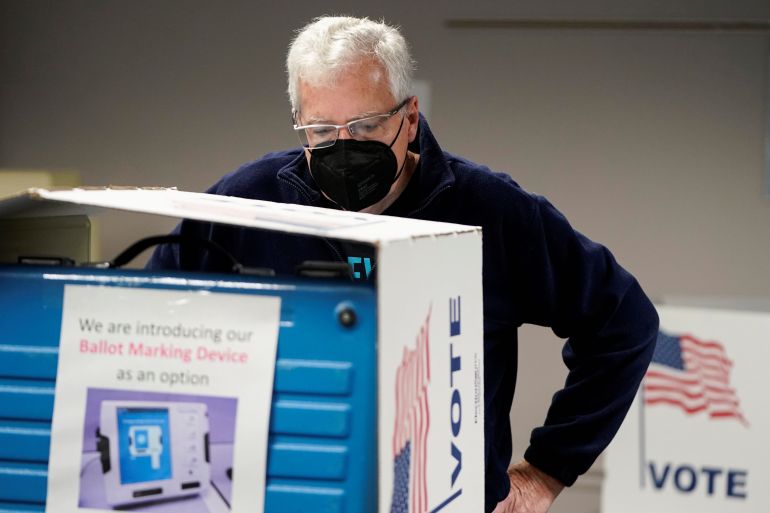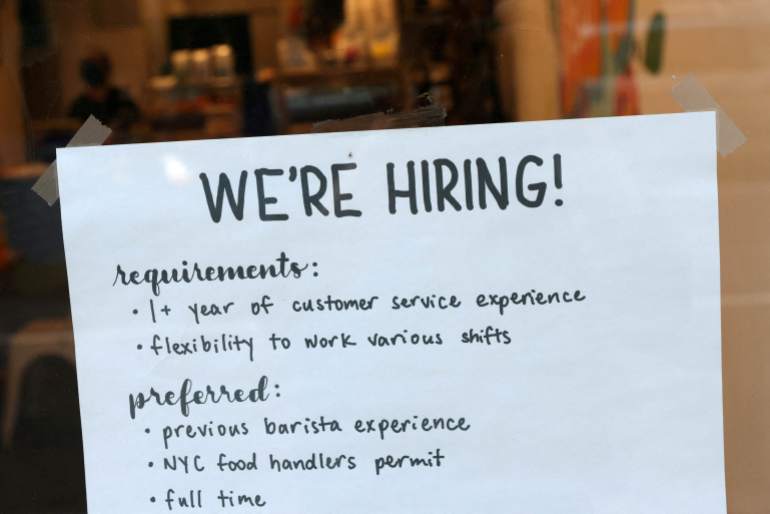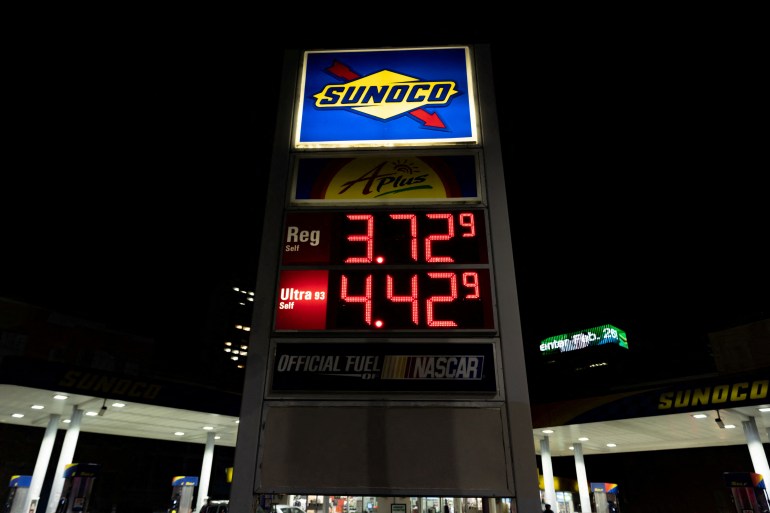US midterm elections: Five economic issues to watch
What economic challenges may sway American voters ahead of elections that will determine who controls the United States Congress?

The state of the economy will outweigh other issues for American voters when they head to the polls next month to decide which party controls the United States Congress, economists have told Al Jazeera.
While there are plenty of hot button issues, including abortion, climate change, crime and immigration, American voters this year are also dealing with the highest inflation rate in decades, a plummeting stock market and talks of an impending recession.
Keep reading
list of 4 itemsTop economic takeaways as US wrangles with recession fears
Europe awaits Nord Stream 1 restart as supply uncertainty swirls
Five things to know about the next US housing crisis
According to a recent Monmouth University poll, 82 percent of Americans consider inflation to be an “extremely or very essential issue” for the federal government to handle. But barely three in 10 Americans approve of President Joe Biden’s handling of the recent jump in the cost of living, the survey found.
At the onset of the pandemic in 2020, the US government began injecting trillions of dollars in stimulus and aid into the economy. COVID-19 ushered in a slew of disruptions, including supply chain crunches and unforeseen changes in consumer behaviour. Two and a half years later, the list of challenges seems to only grow.
“The Russia-Ukraine war is just putting an additional level of pressure on top of the pandemic issues policymakers were already dealing with,” Cristian deRitis, the leading economist at the New York research firm Moody’s, told Al Jazeera.
Biden’s Democratic Party wants to keep control of the US Senate and House of Representatives out of the hands of the Republican Party. If the Democrats lose control of both houses, Biden would face serious policy gridlock over the next two years.
The election is on November 8, which means fresh economic data could continue to sway voters in the weeks ahead. Inflation could stay stubbornly high or break and offer relief. The jobs market is showing signs of weakening and could deteriorate further. And this week, OPEC and its allies, including Russia, agreed to the deepest cut in oil output since the early days of the pandemic, which could mean a jump in petrol prices.
With a month to go before polls open, here are the five economic issues that could influence how Americans vote.
Inflation
Consumer prices surged 8.3 percent in August compared with the same month a year earlier, the government said in September. And while that is down from 8.5 percent in July and a four-decade record of 9.1 percent in June, the number still remains stubbornly high.
“For any government spending, whether it’s good or bad policy, financing boils down to paying for it through taxes,” Kenneth McLaughlin, professor of economics at Hunter College in New York, told Al Jazeera.
“You’re either going to be taxed in the future or you’re going to suffer inflation, and we’re suffering inflation that’s directly connected to the COVID-19 stimulus spending,” he said.
The Federal Reserve, the US central bank, is raising interest rates to make it more pricey for American households and businesses to borrow cash. The goal is to bring supply and demand into balance. Cooling demand will eventually lower prices, the Fed hopes.
But the rate increases haven’t been carried out without controversy. Interest rate hikes spook homebuyers and investors on Wall Street. They risk dipping the economy into a deep recession by eroding demand and damaging long-term economic growth. The Fed will meet again just days before the midterm elections to decide on yet another rate hike.
The Biden administration has added more than $4.8 trillion to the US deficit from 2021 to 2031, according to the Committee for a Responsible Federal Budget, a nonpartisan, nonprofit organization based in Washington, DC.
“The truth is we’re having to pay for policies which there were no plans to pay for,” McLaughlin said. “My main concern is really fiscal responsibility. If Congress and administrations were more fiscally responsible, inflation would take care of itself.”
Unemployment and wage growth
When it comes to the jobs market, a new mantra has surfaced among policymakers and economists: Bad news is good news.
“If unemployment goes up, hopefully just a little bit, that brings inflation under control,” deRitis said. “That’s been the Fed’s playbook.”

But the US jobs market has remained resilient despite the Fed taking action. Data this week, however, did show that US jobs openings fell by 1.1 million in August and jobless claims increased by more than expected. These mixed signals make it difficult to predict just how hawkish the Fed will be in its future rate hikes.
But McLaughlin, who specialises in labour economics at Hunter College, told Al Jazeera that for the average American voter, unemployment and wage growth comes down to brass tacks.
“It’s about what they can afford,” he explained. “It’s their standard of living. It’s wages not keeping up with the price of goods and services.”
The unemployment rate continues to hover at a historic low of 3.7 percent, and job vacancies are high despite talk of an impending recession. Americans remain concerned about jobs, nevertheless. Sixty-eight percent of those asked in the Monmouth survey ranked jobs and unemployment as an extremely or very important issue deserving the government’s attention.
While voters may not head to the polls demanding jobs, the midterms could turn out to be “a wage growth election”, McLaughlin said, adding that in the last year wages have grown 5.2 percent while inflation has soared 8.3 percent.
“That means that people can afford 3 percent less stuff,” he said. “That’s an issue that can motivate voters.”
Petrol prices
While prices at the pump have dropped for four straight months after peaking at a record of $5.06 a gallon ($1.34 a litre) on June 14, there are growing signs that Americans may very soon have to pay more to fill their tanks.
On Wednesday, OPEC and other oil-producing countries, a group known as OPEC+, agreed to production cuts of two million barrels of crude per day to bolster prices.
“Cutting production now with oil above $85 a barrel and inflation rampant is just basic malpractice,” Jim Krane, energy fellow at Rice University in Texas, told Al Jazeera. “Is the cartel signaling that it takes Russia’s wartime needs more seriously than those of the importing world? It sure looks like it.”

The White House has worked hard in recent months to bring petrol prices down.
“Gas prices are always a wildcard in US elections,” Krane said. “Voters mistakenly blame the president and his party for high prices. But in reality, the US government has almost nothing to do with the price of fuel.”
In March as prices at the pump spiked after Russia’s invasion of Ukraine, Biden announced the release of up to 180 million barrels of crude oil from the US Strategic Petroleum Reserve, a stockpile tapped in times of national emergency. The releases were scheduled to end in October, but the White House has since extended that deadline for at least another month and made another 10 million barrels from the reserve available.
With US supplies dwindling as the war in Ukraine roars on and tensions between Russia and the West build, Biden’s options are decreasing fast, Krane said.
“Biden has already leveraged emergency oil stocks,” he said. “Other than that, the US can start getting into draconian policies like export controls, which requires more state control than Americans are comfortable with.”
Housing crisis
Housing is the most interest rate sensitive sector of the economy, deRitis said.
In the past year, interest rates for a 30-year fixed-rate mortgage have more than doubled from 3.01 percent in October 2021 to 6.66 percent this week.
The pandemic sparked a home-buying frenzy in the US and caused home prices to skyrocket. The value of a typical home is currently $356,026 — up 16.5 percent from a year ago.
Higher borrowing costs mean millions of Americans could be locked out of owning a home. Those Americans who had planned to buy a house but can no longer afford it might take that frustration out at the polls.
“If house prices remain high and with the increases in the cost of a mortgage, that makes it more unaffordable for households to buy, and they switch to renting, which actually causes rents to go up,” deRitis said. “The Fed wants housing to slow down. On the one hand, they’re slowing sales, but on the other hand, they are increasing rents, and so inflation continues to rise.”
The unintended consequence of a rise in rents affects a demographic that is already economically vulnerable.
Americans who bought homes during record low interest rates are now in much better economic standing and, therefore, may focus on voting based on issues like abortion and climate change, deRitis said.
“Higher income households aren’t going to be the the economically driven voter,” he said. “They’re exposed to inflation, but it doesn’t hurt them quite as much. So they might be more policy-driven.”
Student loan forgiveness
Student loan debt has been a hot issue for years, especially among millions of young Americans saddled with thousands of dollars of student debt.
In 2020, Biden ran on the promise that he would offer student debt relief to millions of Americans. That was a winning policy for Dara Zucker, a borrower Al Jazeera spoke with in August. She voted for Biden because she believed he would cancel part of her college debt.
By late summer, Biden had announced that he would forgive at least $10,000 in student loans for many debt-laden university graduates earning less than $125,000 a year. Students who received federal Pell Grants for lower-income families would get $20,000 in debt forgiveness.
A backlash has followed the announcement of Biden’s plan. Republicans question how the American people will foot the bill. Biden’s debt cancellation is estimated to cost between $440bn and $600bn over the next 10 years. Polls have showed voters are divided over the issue.
The administration’s plans now seem to be in jeopardy as the policy faces lawsuits and other legal challenges.
Last week, six Republican-led states announced they were suing the Biden administration to stop the president’s plan to forgive student loan debt for tens of millions of Americans. They accused him of overstepping his executive powers.
About 45.4 million Americans hold federal student loan debt.